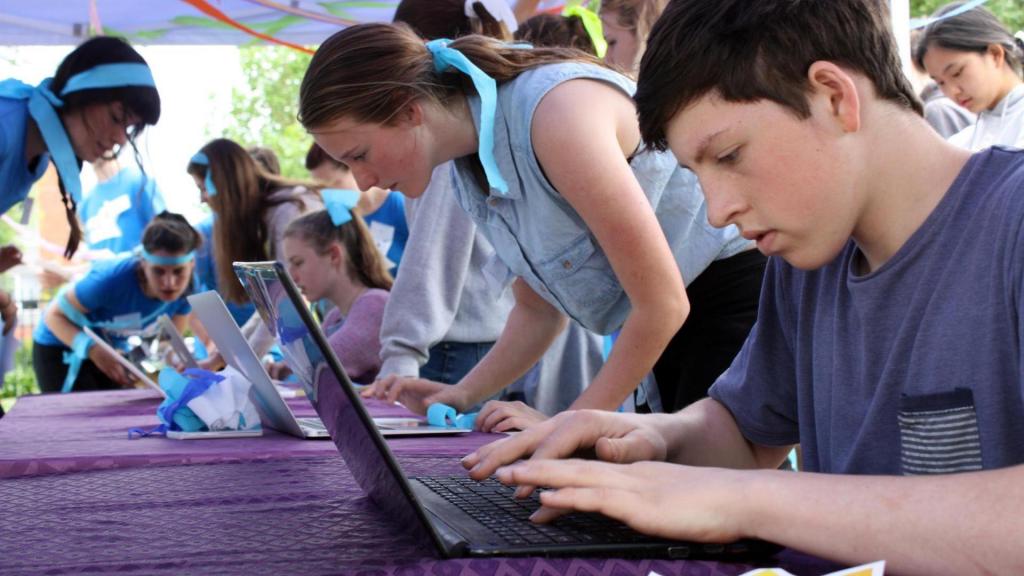"How do I start a sustainability project in my school?"
Once teachers are confident teaching sustainability in the classroom, their next step is to broaden their engagement with sustainability by applying its principles across the school.
In the case studies below, teachers give a snapshot of their project objectives and outcomes with reflections and links to useful resources.
Be assured, there are no 'standard' Education for Sustainability (EfS) projects – they are many and varied! Teachers often start by responding to the needs of their school environment: A garden (see the Mary-Alice Williams profile); a biodiversity audit (Castle Cove primary school); waste reduction and recycling systems (St Columban’s College).
The best projects build on the energy and enthusiasm of the school community and students. Start by mapping stakeholders in your school community and considering how they might be involved. If you need mentors, there are plenty of enthusiastic teachers and supporters in the community who can support you – we now have the wisdom of more than 40 years of environmental education and sustainability in Australian schools.
Project planning templates and the Education for Sustainability Checklist (below) are also a good starting point.
Business case for sustainability
Gaining approval for an EfS project in your school might involve putting a business case to the Principal and seeking support from a range of stakeholders within your school community. Administrative and maintenance staff members are often very important to have on board if your project is an event, or requires support for new systems such as setting up recycling bins. See Glen Huntly Primary School’s Green Evening.
“How many Principals are interested in making substantial savings in their budgets? Students at my school reduced our utilities bill by $10,000 in one year through student-led initiatives, and our paper bill was between $7,000 and $12,000 per year cheaper than my colleagues at a similar-sized school because of our recycling initiatives.
At one school we had growth rates in NAPLAN that were below state average. By introducing authentic learning experiences using Environmental Education in conjunction with the NSW Quality Teaching Framework I saw growth rates in literacy and numeracy one and a half times the state average and we increased student engagement across all key learning areas."
What a sustainable school looks like
Schools can be a powerful force in driving change towards sustainability within our communities. EfS is most effective when implemented through a whole-school approach.
St Louis de Monfort's Primary School in Victoria demonstrated how a whole school can integrate sustainability into its strategic plan, operations, management of infrastructure and curriculum – to the point where sustainability has become a visible part of the St Louis brand.
A whole-school approach reinforces what has been learnt in classrooms and moves students and the school community beyond just developing knowledge and skills about sustainability towards providing the motivation and opportunities to take action for sustainability around the school, in and with their community, to create sustainable patterns of living.
When a school adopts a whole-school approach to EfS, it delivers a clear message that sustainability is at the heart of the school culture, in the curriculum, across all operations and management of the school, and throughout connections and partnerships in the community.
There are a number of models or frameworks available for schools to use to include EfS as a whole-school approach.
The Australian Sustainable Schools Initiative or AuSSI is at the centre of many of the models and frameworks. Participating in these programs provides structured support for the process of reducing water and energy consumption and waste production.
Case Studies

Biodiversity Audit
The Year 5 and 6 students at Castle Cove Primary, NSW, audited biodiversity and adaptations within the school grounds, contributing results to the Atlas of Living Australia.

A green evening
Glen Huntly Primary in Victoria hosted a successful evening event to share their sustainability work with the students and their whole school community.

Building a garden
Arthur Phillip High School in NSW took a whole-school approach to build a vegetable garden and worm farm, improving the school’s overall attitude towards caring for the environment.

Student action group
At St John The Evangelist Catholic High School in NSW, a group of inspired students created 'Johnies Action Group', intent on making St John’s a zero-carbon school.
Handy planning tools
Project planning resources
Environment Education Victoria:
eev.vic.edu.au/resources/project-planning
Education for Sustainability checklist
Steps to integrating sustainability education into your school:
sustainabilityinschools.edu.au/efs-checklist
More case studies in the school
Runcorn State High School (QLD)
Generation Aware campaign:
www.enviroweek.org/generation-aware-campaign
St Columban’s College (QLD)
My impact on the great Pacific garbage patch:
www.enviroweek.org/my-impact-the-great-pacific-garbage-patch/
Mill Park Secondary College (VIC)
Fifty per cent reduction in water bills:
www.myswep.com.au/case-studies/mill-park-secondary-college
St Brigid’s Primary School (NSW)
Ways to learn while reducing our carbon footprint:
www.enviroweek.org/discovering-new-ways-to-learn-while-reducing-carbon-footprint/
Further reference: Models for whole school approaches
The sites listed below provide case studies and examples of how to adopt a whole-school sustainability approach. Many of these models and frameworks are linked to the Australian Sustainable Schools Initiative orAuSSI.
New South Wales
NSW Whole-school planning guide for sustainability
www.environment.nsw.gov.au/sustainableschools/manage/wholeschoolplan.htm
Victoria
ResourceSmart schools
www.sustainability.vic.gov.au/services-and-advice/schools
Yarra Ranges learning for Sustainability framework
lfs.yarraranges.vic.gov.au/lfs/LFS_Program/Follow_the_Program_by_Step
Catholic Education Office Sandhurst Diocese – Kinship of the Earth
South Australia
SA Whole-school planning guide
www.decd.sa.gov.au/efs/files/pages/EfS_guide_Interactive.pdf
Guide to becoming a sustainable school
www.sustainableschools.sa.edu.au/pages/wholeschool/45140/
Introduction to AuSSI-SA
www.sustainableschools.sa.edu.au/pages/wholeschool/33565/?reFlag=1
Queensland
Sustainable schools – Plan, act, review
www.sustainableschools.qld.edu.au/Default.aspx?tabid=372
Sustainable schools – Developing a vision for your school
www.sustainableschools.qld.edu.au/Default.aspx?tabid=114
Australian Capital Territory
ACTSMART schools
www.actsmart.act.gov.au/what-can-i-do/schools/actsmart-schools
Western Australia
Western Australia – Sustainable Schools
Northern Territory
Educating for a sustainable future
Catholic sector
Catholic Earthcare Australia
ASSISI Model
catholicearthcare.org.au/wp-content/uploads/2014/09/a1.-ASSISI-Model-Generic-Dec-2012.pdf
Catholic Education Office Sandhurst Diocese
Global
Eco schools – Making a start for the whole school approach to EfS
www.eco-schools.org/menu/process/seven-steps

